

|
All Photographs © Sam Oppenheim
|
|||||||||||||
| ||||||||||||||
| |||||||||||||||||
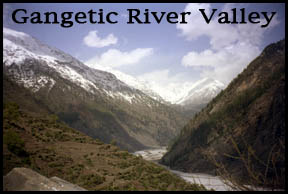 A travel experience,
A travel experience, By Sam Oppenheim The Ganga is the holiest river in India. It is also a goddess and a spiritual analogy for all life-sustaining water in the world as well as the bodies' lifeblood. This past weekend I went on a "Yatra", a pilgrimage, to the source of the river Ganges, high in the Himalayas. The urge to find the source or beginning of a river is an ancient one, but in reality the further back you trace a river the smaller it gets and you pass by many tributaries, so a river actually has infinite sources. Is its true source the furthest North? That is the Bhagirathi which flows from a glacier through Gangotri (Ganga-source) and is considered the source. But perhaps the essence of a river is actually where it is largest. What is a pilgrim in search of the source of the Ganges actually questing for? Perhaps a refinement or the source of our own lifeblood and essential spiritual life essence? Below is recounted one version of my own experience: 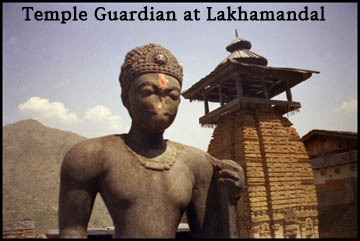 This month (April) I have been staying in Mussoorie, a hill station in the foothills of the Himalayas, 7-10 hours north of Delhi. While studying Hindi, I managed to fit in weekend travel time. Two weeks ago I took two day trips in preparation for my full 3 day excursion to Gangotri this past weekend. My travel companion was Edwin, a good friend of mine from Switzerland who travels the world over. He is a free soul, unattached and easy-going. He was the ideal travel companion and friend, always happy and ready to adapt to all circumstances; Never one to complain, only explain.
This month (April) I have been staying in Mussoorie, a hill station in the foothills of the Himalayas, 7-10 hours north of Delhi. While studying Hindi, I managed to fit in weekend travel time. Two weeks ago I took two day trips in preparation for my full 3 day excursion to Gangotri this past weekend. My travel companion was Edwin, a good friend of mine from Switzerland who travels the world over. He is a free soul, unattached and easy-going. He was the ideal travel companion and friend, always happy and ready to adapt to all circumstances; Never one to complain, only explain.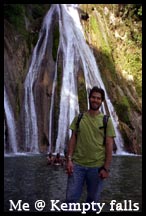 Saturday the 20th we went as far west as one can easily travel in a day trip from Mussoorie. Our destination was Lakhamandal, an ancient temple set in the mountains over the Yamuna River. To get there we traveled down our mountain, past a beautiful waterfall called Kempty Falls, and along the curvy mountain road which runs along the East shore of the Yamuna. This beautiful green mountain river has wound its way down the Himalayas in a more erratic path than the Ganges. In fact, although it begins 100 kilometers from the source of the Ganges (Gangotri), it refuses to lose its own identity and merge with the Ganga until Allahabad. This confluence is many thousands of miles downstream - they run roughly parallel like two ski paths through the mountains and then through the plains of India.
Saturday the 20th we went as far west as one can easily travel in a day trip from Mussoorie. Our destination was Lakhamandal, an ancient temple set in the mountains over the Yamuna River. To get there we traveled down our mountain, past a beautiful waterfall called Kempty Falls, and along the curvy mountain road which runs along the East shore of the Yamuna. This beautiful green mountain river has wound its way down the Himalayas in a more erratic path than the Ganges. In fact, although it begins 100 kilometers from the source of the Ganges (Gangotri), it refuses to lose its own identity and merge with the Ganga until Allahabad. This confluence is many thousands of miles downstream - they run roughly parallel like two ski paths through the mountains and then through the plains of India.We crossed the Yamuna river after noon and soon found Lakhamandal, a Shiva Temple, like most mountain temples. Once there Edwin and I meditated, appreciated the beauty and essence of the region and had to leave by 2pm. Although it was a far journey for the darshan of a single Temple, I was quite glad to have done this and may even return someday. 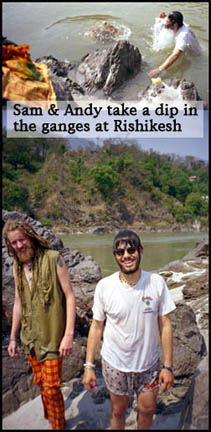
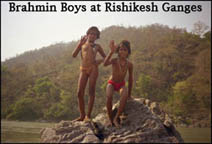 The next day, Sunday, I set off with Em and Andy, two good friends and neighbors from Britain who are also seasoned global travelers. We went down the mountain and traveled west to the Ganges which we followed upstream to Rishikesh. There we dined at Mukti's, which has perhaps the best fresh-cooked food I have ordered from a restaurant in India. In fact, Mukti became friends with my father when he was in Rishikesh last year, and I have followed my fathers footsteps. I enjoyed his delicious made-from-scratch Pumpkin soup, tomato soup, green pasta, gnocchi, and Thai Peanut sauce with vegetables; everything cooked fresh to order! For breakfast I had Banana pancakes or fresh yogurt and honey over fruit and mueslix.
The next day, Sunday, I set off with Em and Andy, two good friends and neighbors from Britain who are also seasoned global travelers. We went down the mountain and traveled west to the Ganges which we followed upstream to Rishikesh. There we dined at Mukti's, which has perhaps the best fresh-cooked food I have ordered from a restaurant in India. In fact, Mukti became friends with my father when he was in Rishikesh last year, and I have followed my fathers footsteps. I enjoyed his delicious made-from-scratch Pumpkin soup, tomato soup, green pasta, gnocchi, and Thai Peanut sauce with vegetables; everything cooked fresh to order! For breakfast I had Banana pancakes or fresh yogurt and honey over fruit and mueslix.Other than a culinary treat, Rishikesh offers shopping, Yoga, and the Ganges. We had a Ganga Dip, a bath in which we dunked under its holy waters, a ritual for blessings and cleansing of our sins. 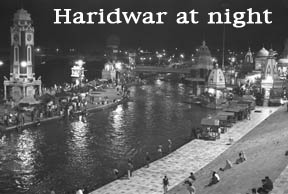 We relaxed in the beautiful hot sun, and ate again at Mukti's before leaving that evening. We stopped in Haridwar, a major Hindu pilgrimage center. We watched pandits perform their daily Ganga Aarti, a prayer followed by a fiery oil lamp propitiation of the river, thanking it for blessing India with rains, water, crops, and life. If this river were to go dry or flood exceedingly, in fact, the repercussions would stretch across all of north India from Haridwar, through Delhi and all the way to Bangladesh and the Bay of Bengal at its mouth. We relaxed in the beautiful hot sun, and ate again at Mukti's before leaving that evening. We stopped in Haridwar, a major Hindu pilgrimage center. We watched pandits perform their daily Ganga Aarti, a prayer followed by a fiery oil lamp propitiation of the river, thanking it for blessing India with rains, water, crops, and life. If this river were to go dry or flood exceedingly, in fact, the repercussions would stretch across all of north India from Haridwar, through Delhi and all the way to Bangladesh and the Bay of Bengal at its mouth.This weekend set the groundwork for my next trip which would be to follow the Ganges as far North as I could. Wednesday and Thursday, April 24th and 25th 2002, were a weather nightmare. The heat from 105-degree Delhi Plains of India clashed with a cold front that swept down from Tibet. This clash dropped a foot or more of rain over two days, nearly nonstop, with lightning and sometimes hail. Edwin was still ready to go to Gangotri and so was Davey, our excellent Cab driver who also drove us the previous weekend. Friday morning before dawn at 3:30 am Edwin and I hiked down the path behind his lodge to the road, carrying all our supplies for a cold weather mountain trek. We met Davey and drove under the Waxing Gibbus moon, a harbinger of the full moon to come. 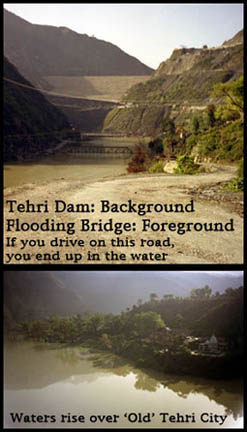 Our first stop (after a morning Chai) was at Tehri. This city is at the confluence of two tributaries of the Ganges, both flowing from the same Glacier. We would follow the larger Bhagirathi river, to Gangotri. Tehri is also the site of the controversial Tehri Dam. This huge earthen and concrete mound has blocked the Ganges to provide flood control, and more importantly, electricity to Delhi for Air Conditioners. India has a deplorable electricity supply shortage. Unfortunately, however, the scale of this project is excessively massive. It will not only flood Old Tehri, a historic city on the confluence point, but also over 40 surrounding hillside villages and hamlets. More shockingly, the dam is built across a known seismic faultline.
Our first stop (after a morning Chai) was at Tehri. This city is at the confluence of two tributaries of the Ganges, both flowing from the same Glacier. We would follow the larger Bhagirathi river, to Gangotri. Tehri is also the site of the controversial Tehri Dam. This huge earthen and concrete mound has blocked the Ganges to provide flood control, and more importantly, electricity to Delhi for Air Conditioners. India has a deplorable electricity supply shortage. Unfortunately, however, the scale of this project is excessively massive. It will not only flood Old Tehri, a historic city on the confluence point, but also over 40 surrounding hillside villages and hamlets. More shockingly, the dam is built across a known seismic faultline.Little white 'tombstones' ironically mark the height to which water will eventually fill the valley. You can watch them as you drive for miles along mountain roads up the valley. In the short term, some people have benefited by building a new home every time the government pays them to evacuate the previous one. They have reaped large monetary benefits from governmental inadequacy. Meanwhile, others have not been compensated at all because they cannot prove ownership of their house, perhaps they began by squatting on the property decades ago but never received a legal title. 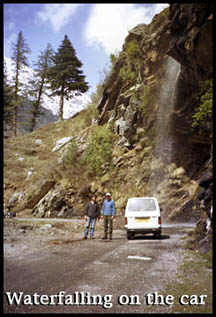 In any case the real problem with this dam is that the government of India has given Mother Nature or the Goddess Ganga, real power over their entire country's livelihood. If she ever wanted to clean up the polluted dirty cities lining her shore, a flood from this dam breaking would destroy Rishikesh, Haridwar, Delhi, and perhaps even all of Bangladesh which is built on Ganga's low, loose, sandy mouth.
In any case the real problem with this dam is that the government of India has given Mother Nature or the Goddess Ganga, real power over their entire country's livelihood. If she ever wanted to clean up the polluted dirty cities lining her shore, a flood from this dam breaking would destroy Rishikesh, Haridwar, Delhi, and perhaps even all of Bangladesh which is built on Ganga's low, loose, sandy mouth.We merely gawked in awe at the houses and bridge that were already partially submerged, looking up the hillsides and imagining the whole valley filled with water. Edwin and I then drove past Uttarkashi, the transportation hub of this region. As we climbed, we glimpsed snow-capped hills in the distance, drove over and under waterfalls, including one which washed our whole car. Then, nearing Gangotri we had to pass over partially washed out roadsides, areas where rocks and mud had slid down the hill in this winter's storms, sometimes washing away some of the road. At one point I had to push the car as it got stuck in mud. Edwin and I finally began our trekking portion of the pilgrimage when we disembarked in Gangotri at 4pm. Although the sun was low in the sky and there was snow on the ground, we packed our backpacks and began to hike. We hoped to clear 14 kilometers and spend the night in Bhojbhasa, 4-5 kilometers from Gaumukh, "Cows' face", the glacier from which the Bhagirathi river, and thus the Ganga, begins. Soon after beginning, however, we were challenged by sections of the path that had been washed out. Scrambling over the rock-fall debris path we passed over the negative space where we could see the path had once gone. The real danger was not only slipping and falling, but more rocks falling from above. Luckily we were both on separate sides when a boulder as large as me came between us and reminded us to be cautious. 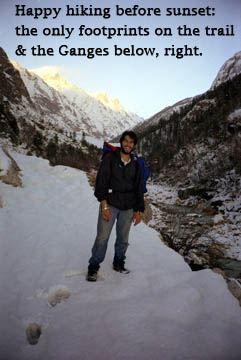 The pilgrimage season officially begins on a different day each year, determined by weather, politics, and Brahmin priests. This winter was especially fierce, the worst in 25 years, and we would later learn that even though it is Spring/Summer and nearly Monsoon time, the past days' storm had dropped as much snow here as it had rain in Mussoorie: almost 40 centimeters - over a foot! Therefore the path continued to be covered and washed away at various intervals. We eventually crossed over 20 snowbanks, huge masses of snow 40-50 feet deep and stretching from the Gangetic valley up and over the trail toward the point at which the mountain became too steep to hold snow. These may have been avalanches when forming, but by now they were compacted hills. We had to march over our feet slipping down half way to our knees into fresh snow and our balance was necessary on the steeper sections to prevent a long slide downhill.
The pilgrimage season officially begins on a different day each year, determined by weather, politics, and Brahmin priests. This winter was especially fierce, the worst in 25 years, and we would later learn that even though it is Spring/Summer and nearly Monsoon time, the past days' storm had dropped as much snow here as it had rain in Mussoorie: almost 40 centimeters - over a foot! Therefore the path continued to be covered and washed away at various intervals. We eventually crossed over 20 snowbanks, huge masses of snow 40-50 feet deep and stretching from the Gangetic valley up and over the trail toward the point at which the mountain became too steep to hold snow. These may have been avalanches when forming, but by now they were compacted hills. We had to march over our feet slipping down half way to our knees into fresh snow and our balance was necessary on the steeper sections to prevent a long slide downhill.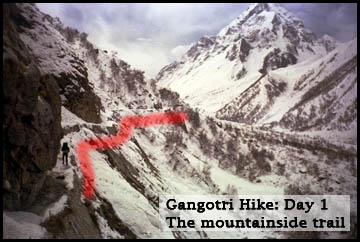 The whole hike had been following the river valley up a slowly slanting hillside trail, at times cut into granite, other times over loose dirt clinging to the mountainside. The air smelled fresh, and our footsteps were the only ones in the snow. As far as we could tell we were the only people in the whole valley, it felt like we were the only people in the world. It felt wonderful and this is how I became addicted to the Himalayas. Apparently nobody had hiked this area in three days, since the snowstorm, and our forging ahead over snowbanks was a form of trailblazing, setting footsteps for others to follow later. As far behind us and in front of us as we could see was the grayish aquamarine rapids of the Ganga, flowing spectacularly over smoothed rocks, forming rapids. This sound carried across the valley like a constant beautiful reminder of our place in nature. As we were barely in the tree line, the pine trees were more below us and behind us rather than in front, so the mountains we gazed at were spectacular fresh, sharp, barely weathered rock. Unlike anything you can see unless you travel toward a young, high mountain range like the Himalayas.
The whole hike had been following the river valley up a slowly slanting hillside trail, at times cut into granite, other times over loose dirt clinging to the mountainside. The air smelled fresh, and our footsteps were the only ones in the snow. As far as we could tell we were the only people in the whole valley, it felt like we were the only people in the world. It felt wonderful and this is how I became addicted to the Himalayas. Apparently nobody had hiked this area in three days, since the snowstorm, and our forging ahead over snowbanks was a form of trailblazing, setting footsteps for others to follow later. As far behind us and in front of us as we could see was the grayish aquamarine rapids of the Ganga, flowing spectacularly over smoothed rocks, forming rapids. This sound carried across the valley like a constant beautiful reminder of our place in nature. As we were barely in the tree line, the pine trees were more below us and behind us rather than in front, so the mountains we gazed at were spectacular fresh, sharp, barely weathered rock. Unlike anything you can see unless you travel toward a young, high mountain range like the Himalayas.Each mountain face had its own character, a sharpness here and tenderness there. Snow caressed these tops sparsely wherever it could find a crack or slightly less sheer face. The sun was strong however, and this snow was quickly melting, running down each mountain in its own haphazard fashion, eventually finding a gully to stream down or cascading beautifully over us. We had to cross over a few of these streams on a felled log, and we also walked under beautiful waterfalls. The more annoying variant was the water which chose as its course our own path. Since my shoes were not waterproof, within a few hours I had cold, wet feet. 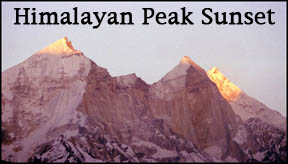 The suns' last rays painted the mountaintops first orange, and then magenta. The winds that follow a sunset began to blow, cooling off the valley to zero degrees in less than an hour. The naked mountaintops, exposed to the fiercest winds, began to 'sweat' a fine powder of snow - like a cloud or mist from the mountaintop this blew in the same way loose fabric edges waver around a woman in the wind. The scariest and most beautiful portion of that day's hike, however, may have been after the sun had set.
The suns' last rays painted the mountaintops first orange, and then magenta. The winds that follow a sunset began to blow, cooling off the valley to zero degrees in less than an hour. The naked mountaintops, exposed to the fiercest winds, began to 'sweat' a fine powder of snow - like a cloud or mist from the mountaintop this blew in the same way loose fabric edges waver around a woman in the wind. The scariest and most beautiful portion of that day's hike, however, may have been after the sun had set.We noticed we had not yet made it half-way toward our destination. Continuing in the remaining daylight, we approached a massive avalanche. This snowslide had come down the opposing side of the mountain, and then washed up our side like a wave, falling back upon itself. It was at least three days old, as new snow had covered it, and it was smooth on our side, but the massive volume of snow was impressive, crossing it may have taken over 30 minutes of sluggish hiking. This exhausted us and when we glimpsed a blue glow behind the highest, sharpest nearby mountain, we sat down to receive the Darshan (blessed vision)that Mother Nature had in store for us: The full moon began as a blue glow like electric lights used for nighttime construction, eclipsing the face of the mountain from behind. Then slowly it rose at a 45 degree angle from behind the crooked sharp peak. This all occurred behind the misty snow blowing off the summit. We stared in blissful awe of this natural phenomenon. What are the chances that one can hike under a clear sky through snow with a full moon? We really enjoyed this experience and the wonderful nighttime hike. We safely maneuvered across the snowbanks with the moon lighting our path far brighter than any flashlight could have. Finally after fording a rocky stream with no bridge, Edwin and I both accidentally slipped into its icy waters with one foot, chilling us further and determining that the time had begun to search for a place to camp for the night, we would not reach Bhojbasa that evening. 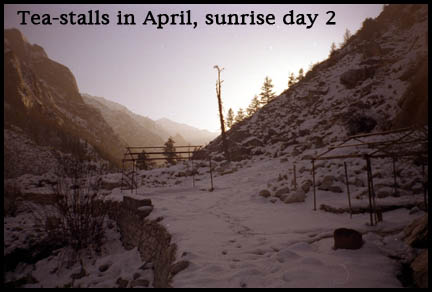 We found an empty stall for serving chai during the tourist season and slept on a concrete floor under a metal frame with a roof and no walls. We found some tarps covering equipment, and threw them over us for extra insulation and began to thaw ourselves out. My left foot was numb for 3 hours and as I drifted in and out of fitful frigid sleep I massaged it, fearing the worst: frostbite and imminent amputation of a toe or two. Finally by 2am I had nerve-ending activity in all fingers and toes and slept soundly until sunrise.
We found an empty stall for serving chai during the tourist season and slept on a concrete floor under a metal frame with a roof and no walls. We found some tarps covering equipment, and threw them over us for extra insulation and began to thaw ourselves out. My left foot was numb for 3 hours and as I drifted in and out of fitful frigid sleep I massaged it, fearing the worst: frostbite and imminent amputation of a toe or two. Finally by 2am I had nerve-ending activity in all fingers and toes and slept soundly until sunrise.I peeled my frozen socks off my shoes and whacked the ice off my jeans pantlegs. We left these frozen articles in the bright morning sun to defrost and relaxed while packing up our equipment and eating a breakfast of some remaining cinnamon bread, nuts, glucose biscuits, and dried fruit. Suddenly a man from Utah appeared, jealous we had hiked at night and made the first tracks. We gave him some provisions and saw him happily begin his own further trek to find his friends farther up who had been snowed in for days, and one of which had a flight home from Delhi the next day! Then before our shoes had fully thawed out, three chowkidars (watchmen) appeared on the path and came to set up the 'building' we had slept in. In fact they even boiled some water and served us Chai!!! This treat warmed us up and we shortly began our second arduous day of hiking. 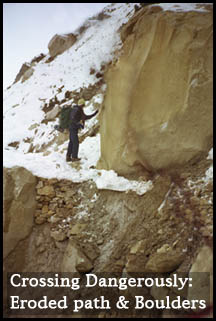 We hiked for 3 hours to Bhojbasa, the most difficult passes made even more difficult because of the hot days' sun which melted mud and snow alike. I had to cross under a boulder on a 4-inch dirt ledge, extending for 10 longitudinal feet across a patch where the path had been swept down the hill. This scared me and when my first step launched 2 inches of the 4-inch margin downhill, I really became terrified. Edwin assured me I could pass by setting my foot farther ahead of the 2 inch margin where 4 inches remained. I did cross this part, shaken up and unsure how to pass it the next day. While crossing another 'danger zone' I heard a rock falling from above and tried to gauge which way it would fall. I was in the middle of a pathless rock strewn rockslide area and I hugged the nearest stable boulder, hoping it would shield me from the 100-pound menace tumbling down toward me. Edwin shouted "ATTENTION! ATTENTION!" and I looked up again: it was coming down toward me fast. It passed 4-6 feet to my left and I quickly walked farther to the safer area where the path reappeared and less rocks were precariously perched on melting mud.
We hiked for 3 hours to Bhojbasa, the most difficult passes made even more difficult because of the hot days' sun which melted mud and snow alike. I had to cross under a boulder on a 4-inch dirt ledge, extending for 10 longitudinal feet across a patch where the path had been swept down the hill. This scared me and when my first step launched 2 inches of the 4-inch margin downhill, I really became terrified. Edwin assured me I could pass by setting my foot farther ahead of the 2 inch margin where 4 inches remained. I did cross this part, shaken up and unsure how to pass it the next day. While crossing another 'danger zone' I heard a rock falling from above and tried to gauge which way it would fall. I was in the middle of a pathless rock strewn rockslide area and I hugged the nearest stable boulder, hoping it would shield me from the 100-pound menace tumbling down toward me. Edwin shouted "ATTENTION! ATTENTION!" and I looked up again: it was coming down toward me fast. It passed 4-6 feet to my left and I quickly walked farther to the safer area where the path reappeared and less rocks were precariously perched on melting mud.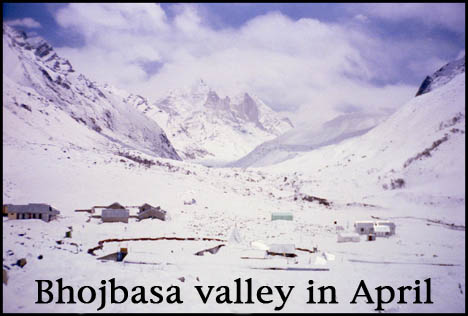 By 1 pm we finally reached Bhojbasa, at 3,800 meters, or nearly 12,000 feet. I had a high altitude headache and the stirrings of a throat cold. Edwin was exhausted and recommended we rest. The only occupants were at Lal Baba's Ashram: a year round residency here in the Gangetic valley below the glacier. We got a room and had fresh cooked Dal. It tasted so refreshing. We then meditated and slept until Chai at 4 pm.
By 1 pm we finally reached Bhojbasa, at 3,800 meters, or nearly 12,000 feet. I had a high altitude headache and the stirrings of a throat cold. Edwin was exhausted and recommended we rest. The only occupants were at Lal Baba's Ashram: a year round residency here in the Gangetic valley below the glacier. We got a room and had fresh cooked Dal. It tasted so refreshing. We then meditated and slept until Chai at 4 pm.Ominous clouds and darkening sky announced the possibility of snow and more weather deterring further hiking. The glacier was 4 kilometers distant, but to hike 8 km round trip would now be pushing our bodies limit, and the altitude would be above 4,000 meters at Gaumukh, the glacier. Therefore we rested up for the next day when we would have to retrace our steps homeward, unless it snowed something fierce. The next morning I went to the Ganga: this was the closest to her source I would come, and thus I made offerings and did puja. I gave her some coins including an American quarter, I also gave her some other meaningful items including my Red Coral pendant. This was an unintentional gift, the Ganges took it from me, but I have heard stories from so many pilgrims that I know it was meaningful and ordained. This was a token which I would never have willingly given, but that it was given is a fact, and this teaches me many lessons on different levels. I also drank its clear grayish waters, colored and flavored by glacial silt. Then I prayed for all my loved ones and thanked the river for her life giving waters, both for India and in a more abstract sense for all water. All water molecules, like all souls, are one. On a geological timescale, all water in the world, even frozen in glaciers and poles, is part of the same connected systemic body, as all souls are part of God. 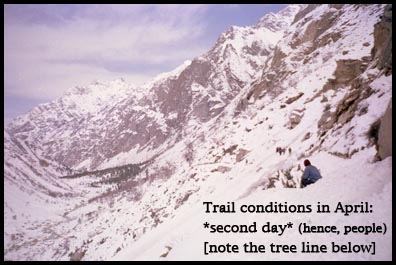
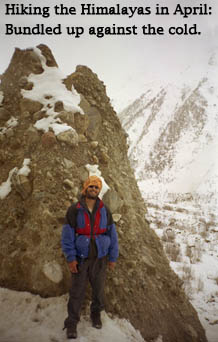 The walk back was easier, the sun was clouded over and the cold preserved the structural integrity of stones and snow banks, preventing landslides and rock falls. In fact the cold kept the icy crust on the snow firm so that our feet sank much less deeply. This conserved energy, as did the downhill grade and more oxygen rich air at lower altitudes. The light snow falling graced us like fresh air and fairy dust. In all it was perfect hiking weather and we even got to stop in our old 'home' which now had our 'blankets' (tarps) hung up as walls, and we had chai while sitting at their fire. Later, in Gangotri we found the place deserted, electricity and water supply will be provided in two weeks when the pilgrimage season officially begins. This is when the goddess Ganga returns to Gangotri temple in a procession from her winter abode in a temple further downstream. One kitchen and rest-house was open, and our cab driver had slept there and was eating lunch when we returned.
The walk back was easier, the sun was clouded over and the cold preserved the structural integrity of stones and snow banks, preventing landslides and rock falls. In fact the cold kept the icy crust on the snow firm so that our feet sank much less deeply. This conserved energy, as did the downhill grade and more oxygen rich air at lower altitudes. The light snow falling graced us like fresh air and fairy dust. In all it was perfect hiking weather and we even got to stop in our old 'home' which now had our 'blankets' (tarps) hung up as walls, and we had chai while sitting at their fire. Later, in Gangotri we found the place deserted, electricity and water supply will be provided in two weeks when the pilgrimage season officially begins. This is when the goddess Ganga returns to Gangotri temple in a procession from her winter abode in a temple further downstream. One kitchen and rest-house was open, and our cab driver had slept there and was eating lunch when we returned.The drive home was interrupted twice by major events, and constantly by memories and thoughts about how spectacular and special the pilgrimage hiking experience had been. The first stop was an hour or so later when we arrived at Gangnani (Grandmother of the Ganga). This natural hot spring flows from the mountain into a cement bathing platform which is described during pilgrimage season as a fetid soapscum and garbage filled cauldron. (Indians use it like a bathtub with soap and even doing laundry there.) However, as we were two weeks early, there was only three others there and our muscles immediately relaxed upon immersion in the near-boiling sulpherous water. As my pores opened up, my bones soaked in the heat by osmosis and I was warmed up in every part of my being. My aching muscles thanked me for the salubrious treatment. Finally, our driver took us to fill up gas just 5 minutes before closing at the only petrol pump for 200 kilometers! Then we ate dinner and drove down the last 4 hours of road between 10pm and 2am. We were blessed by catching the Van Gujjars coming toward us in the opposite direction. These nomadic muslim people are famous for their buffalo: the biggest healthiest most beautiful animals in the Himalayas. They wait each spring for their buffalo to begin to move north. This signals Mother Nature's readiness for their annual pilgrimage to glacial valleys. They move their huge herds up hundreds of miles of road and trail to find pastures hidden in the highest valleys of the Himalayas. Here each summer blooms rich fodder, grasses and flowers, which feed their herds until their return to the lower hills in the fall. Our driver had never seen them and explained that they move more often at night to avoid traffic on the roads, and cover ground incredibly fast, so that they are not seen by tourists unless they chance upon them like we were blessed to have! The Gujjars wear fantastic moustaches, and camped on the roadside under strung blankets. As we continued into the late night we saw many more either camping or moving up the road with their buffalo. As we passed these buffalo I was awestruck by these beautiful beasts, the only comparison in the whole world for beauty and size is the American Bison. At one roadside patch we saw over 200 head, the largest group that evening. They all obediently laid down like soldiers in an orderly regiment. These animals were huge and healthy, obviously not only treated well, but also strong willed and fairly intelligent. [Edit: The Gujjars are now in danger of losing their way of life : more info ] Finally, Edwin and I arrived home, exhausted but emotionally, physically, intellectually, and spiritually fulfilled. The success of our Yatra (journey or pilgrimage) could not be surpassed. |